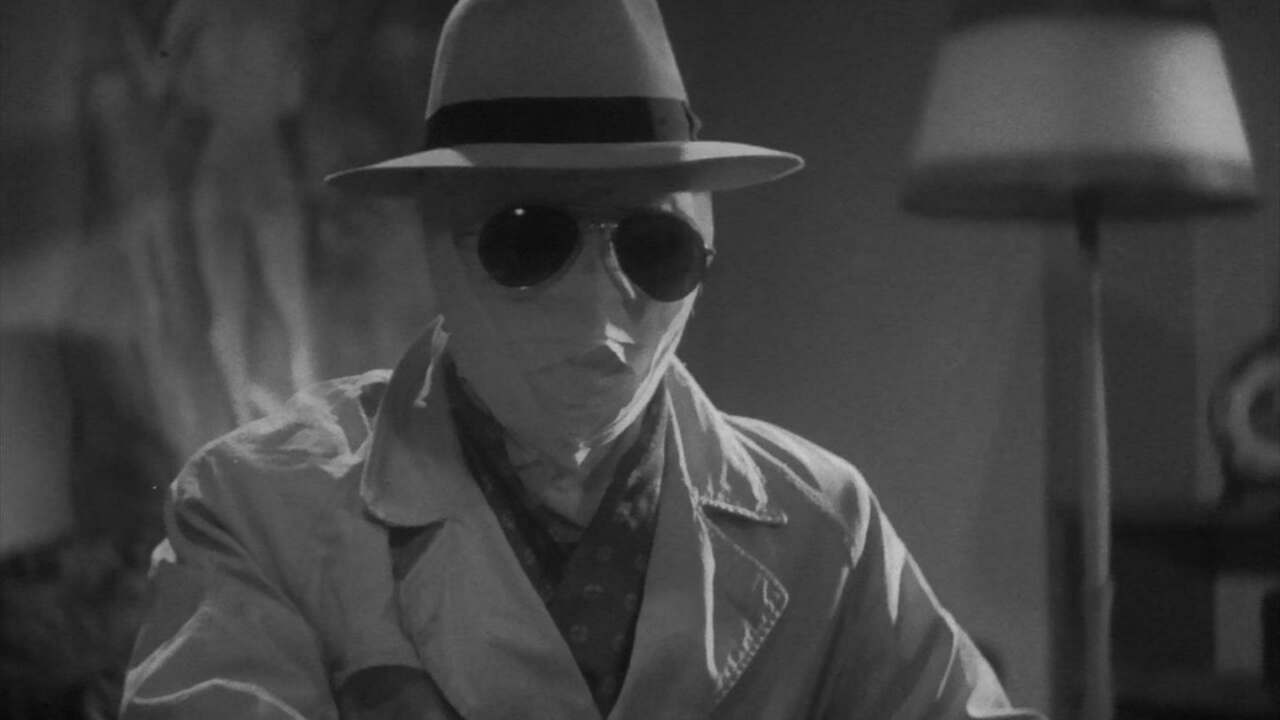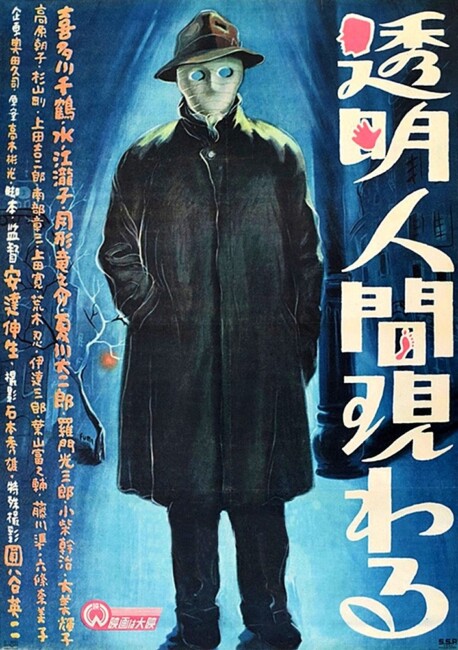(Tomei Ningen Arawaru)
Japan. 1949.
Crew
Director/Screenplay – Nobuo Adachi, Story – Akimitsu Takagi, Photography (b&w) – Hideo Nishimoto, Music – Goro Nishi, Special Effects Supervisor – Eiji Tsuburaya. Production Company – Daiei.
Cast
Ryunosuke Tsukigata (Dr Kenzo Nakagato), Tsuyoshi Sugiyama (Ichiro Kawabe), Kanji Koshiba (Shunji Kurokawa), Chizuru Kitagawa (Machiko Nakazato), Daijiro Natsukawa (Kyosuke Segi), Hiroshi Ueda (Nagayoshi Tanimoto), Minako Rokujo (Toshiko Nakazato), Asako Takahara (Motoko Nakazato), Mitsuaburo Ramon (Inspector Matsubara), Takehiro Yuasa (Drunk)
Plot
In Kobe, Dr Kenzo Nakagato is developing an invisibility formula. His two assistants, Kurokawa and Segi, are working on similar lines of research and he promises the hand of his daughter Machiko to the one who succeeds. Dr Nakagato demonstrates the formula to the businessman Ichiro Kawabe, making the family’s cat invisible, but warns that he has not yet found a means to reverse the process. Dr Nakagato then disappears, leaving only a note saying he has gone into hiding to further his research. An invisible man then appears, conducting the robbery of a jewellery store and taking a valuable diamond pendant, leaving behind a card indicating he is Dr Nakagato.
The Invisible Man Appears is an obscure Japanese film – it is so obscure that the internet gives differing dates for its release with both 1949 and 1951 being listed by different sites. It predates the great era of Japanese fantastic cinema that began with Godzilla (1954) and continued through into the 1970s, producing a great many monster movies, alien invasion films and space operas. Daiei, the production company that made the film, did go on to produce a Godzilla copy with Gammera the Invincible (1965), which spun off a long-running series of sequels of its own. The greatest footnote this has in film history is that it was one of the other non-Toho films made by Eiji Tsuburaya who supervised the special effects for Godzilla and most of Toho’s monster films up until his death in 1970.
The film was apparently inspired after the filmmakers saw Universal’s The Invisible Man (1933) or one of its sequels during the US occupation of Japan. The Invisible Man here is a similar figure to Griffin, dressed and outfitted in almost identical ways in hat, overcoat, bandaged face and sunglasses. In particular, the scene where the Invisible Man unmasks himself, peeling off his hat, coat and bandages in front of the jewellery clerk seems modelled on Claude Rains’ similar unveiling in The Invisible Man.
The almost completely unknown director Nobuo Adachi gives the film some moody effect with the use of assorted Dutch angles and strong lighting schemes that make the most of the black-and-white photography. As with later Toho films like The H-Man (1958), The Human Vapor (1960) and Secret of the Telegian (1960), the film features a novel Super-Villain who is placed into what is otherwise a mundane crime plot. This is mostly centred around the schemings of a businessman and the attempts to procure a valuable diamond pendant.

Eiji Tsuburaya does his best with the effects. There are some quite decent ones – like where an invisible cat knocks over vases, lamps and walks along the keys of a piano. The big dramatic set-piece is where the Invisible Man strips off in front of the jeweller. Both this and the scene not long after where the Invisible Man strips the clothes off a drunk and puts them on in the street have great imagination but are let down by shoddy optical work.
Daiei later made a sequel with The Invisible Man vs the Human Fly (1957).
Director Nobuo Adachi made seventeen films between 1949 and 1953. Little is known about most of these. His one other genre work was the horror film Claws of Steel (1951).
Trailer here


